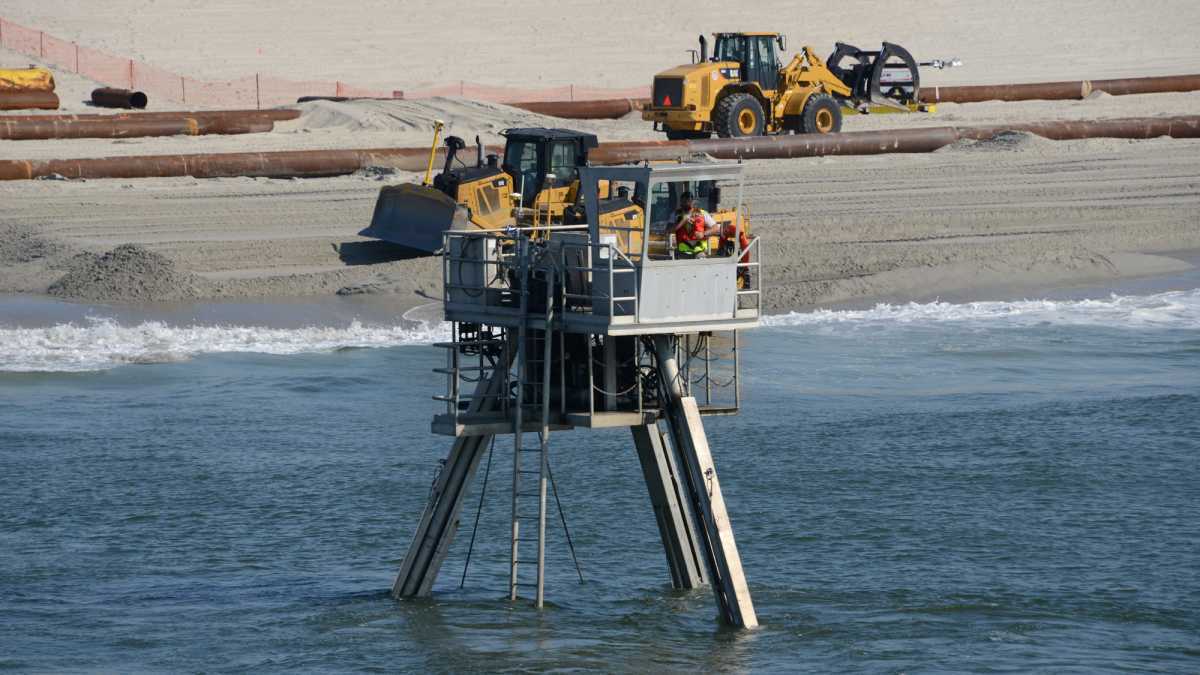N.J. announces beach replenishment schedule for Ocean County’s northern barrier island

A Coastal Research Amphibious Buggy (CRAB) surveys the surf area of Brant Beach, NJ during a restoration project in June of 2013. (Photo by USACE)
A project that includes the construction of engineered beaches and protective dunes along a 14 mile stretch of the northern Ocean County peninsula will begin next month in the vulnerable Ortley Beach section of Toms River, Department of Environmental Protection Commissioner Bob Martin announced today.
Ortley Beach, known as “ground zero” for the catastrophic property damage inflicted by Superstorm Sandy, will receive approximately 267,000 cubic yards of sand, creating an approximately 225-foot-wide beach over the course of two weeks next month before taking a hiatus, the state said in a release.
Work on other beaches in northern Ocean County will occur during the summer and into early next year. Crews will return to Ortley Beach during the fall to complete the dune and beach construction work.
The tentative schedule is as follows:
Ortley Beach (initial beachfill): Mid-April 2017 through late April 2017
Mantoloking: Early July 2017 through September 2017
Seaside Heights: Late September 2017 through October 2017
Seaside Park: Late October 2017 through late December 2017
Ortley Beach (completion): Mid-October 2017 to mid-December 2017
Brick: Winter 2018
Normandy Beach (Toms River): Winter 2018
Lavallette: Spring 2018
The schedules for Bay Head, Point Pleasant Beach and Berkeley Township will be determined as necessary outstanding easements are obtained.
“We are particularly pleased that work is beginning in Ortley Beach, which sustained such extensive property damage because it did not have a properly engineered beach and dune system when Superstorm Sandy struck,” Martin said.
Earlier this year, the Army Corps of Engineers, in conjunction with the DEP, awarded a base contract of $92 million to Weeks Marine of Cranford, New Jersey to conduct the first phase of construction.
Officials say the ultimate contract amount is expected to reach about $128 million as crews advance work in areas where the state continues to seek access easements from property owners.
According to project details, offshore pumping will supply some 11 million cubic yards of sand to build dunes 22 feet above sea level and 100 to 300 foot wide beaches 8.5 feet above sea level for most of the project area. Periodic replenishment projects over 50 years will replace sand lost to normal erosion.
Crews will use multiple-suction hopper dredges to pull up sand from offshore along with a cutter-head dredge, which is a large barge that sits offshore and pumps sand continuously onto the beach by way of a pipeline. Work will progress in 1,000-foot sections.
65 percent of the funding will come from the 2013 federal Disaster Relief Appropriations Act, while the state will fund the remaining 35 percent from the Shore Protection Fund.
In Sept. 2016, Jeff Tittel of the New Jersey Sierra Club said the project’s funding should be going toward other methods in dealing with flooding risks.
“What this area really needs is a dune system, elevating homes, and buyouts. The federal monies coming in for rebuilding should be going towards adaptation and mitigation, restoring natural systems and requiring green buildings and energy efficiency,” he said. “We should be implementing adaptation and mitigation planning and reducing carbon pollution. The Christie Administration’s failure to deal with climate change has not only wasted millions of dollars, but put people at risk.”
WHYY is your source for fact-based, in-depth journalism and information. As a nonprofit organization, we rely on financial support from readers like you. Please give today.

